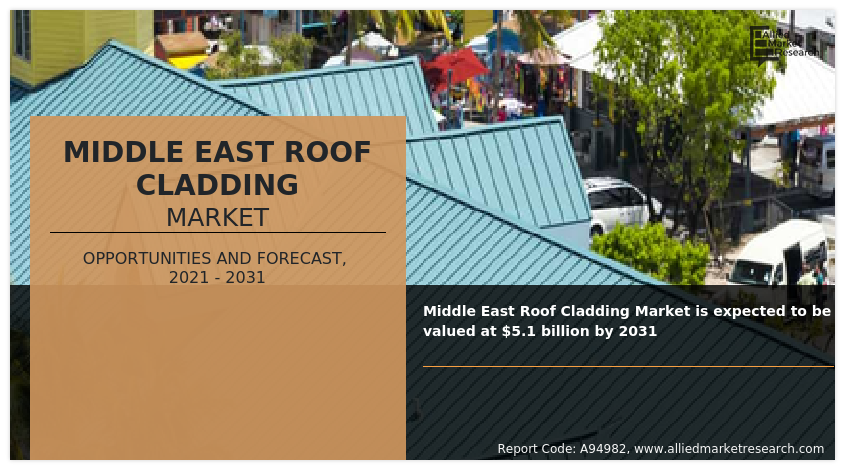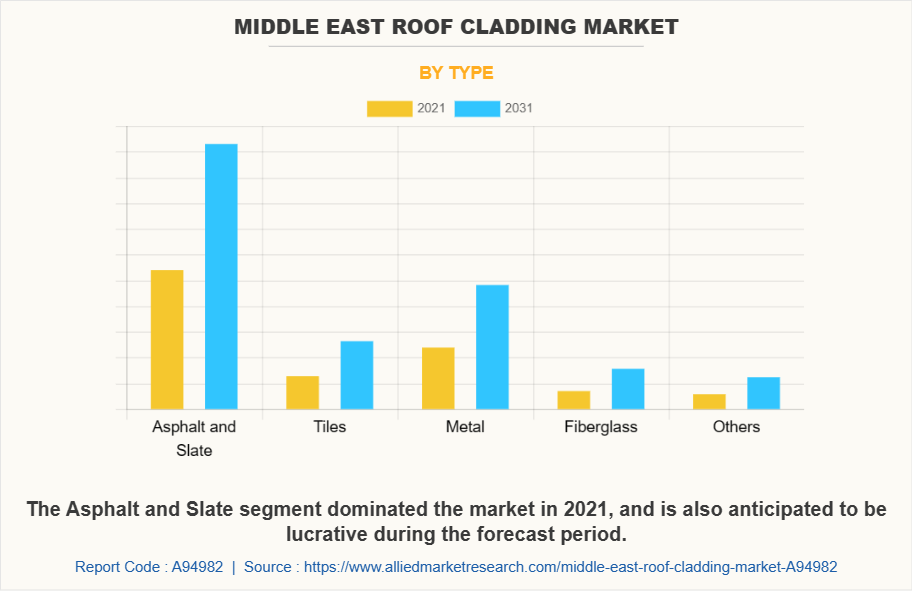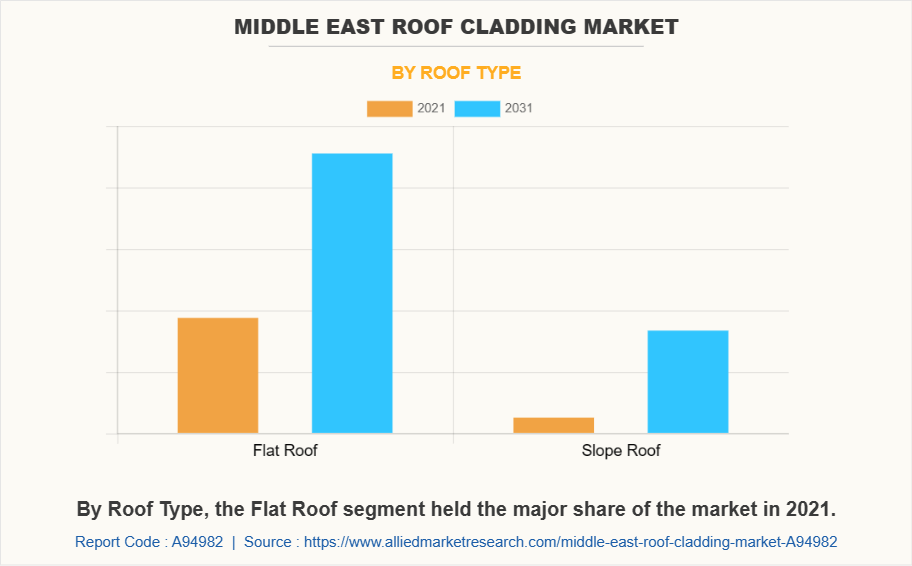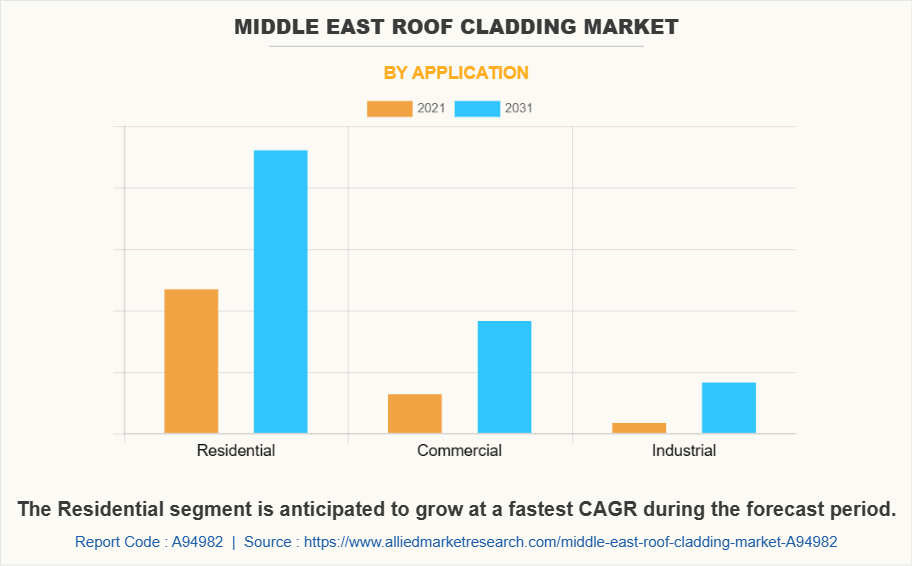The Middle East roof cladding market has witnessed substantial growth due to several factors. The Middle East's thriving construction industry is a key driver in the market, with a multitude of residential, commercial, and industrial projects sprouting up. This surge in construction activity creates a need for durable and high-quality roofing solutions, leading to an increased demand for roof cladding materials. In addition, extreme climatic conditions in the Middle East, characterized by scorching summers and occasional sandstorms, necessitate resilient roofing systems. Roof cladding provides essential protection against these elements, making it an indispensable component in the construction sector. As a result, the demand for roof cladding materials in the Middle East is propelled.

On the other hand, market restraints in the Middle East roof cladding market arise from economic fluctuations and geopolitical uncertainties, which have the potential to disrupt its steady growth. Political instability and economic downturns discourage investors and developers, consequently impacting the construction sector and the demand for roof cladding materials. Moreover, high cost of raw materials influences the pricing of roof cladding products. Therefore, manufacturers prioritize optimizing their production processes and exploring cost-effective alternatives while maintaining high quality.
However, there are ample opportunities for innovation and expansion in the Middle East roof cladding market. The region's flourishing economy and rise in disposable income provide manufacturers with an opportunity to provide tailored and high-end solutions to cater to the diverse preferences of consumers. In addition, incorporation of advanced technologies in the manufacturing process paves the way for growth, resulting in enhanced efficiency, reduced expenses, and superior product quality.
The Middle East roof cladding market is segmented into type, roof type, and application. On the basis of type, it is segregated into asphalt & slate, tiles, metal, fiberglass, and others. By roof type, the market is classified into flat roof and slope roof. Depending on application, it is fragmented into residential, commercial, and industrial.

Residential applications demonstrate substantial potential, as evidenced by a segmental analysis of the market. The Middle East is currently undergoing a notable urbanization trend, resulting in a rise in residential construction endeavors. Roof cladding materials specifically tailored for residential use are projected to witness robust demand, especially those that boast both aesthetic appeal and energy efficiency.
The improvement of roof cladding materials is a crucial factor in the development of new products. Manufacturers are continuously working to enhance durability, energy efficiency, and aesthetics. R&D efforts are focused on improving the overall quality and performance of these materials to withstand the extreme weather conditions in the Middle East. In addition to technical aspects, consumer and end-user perceptions play a vital role. Homeowners, builders, and architects are now looking for roof cladding solutions that offer structural integrity and enhance the overall aesthetic appeal of buildings. The aesthetic component has become a significant influencer in the market.

Furthermore, manufacturers in the Middle East roof cladding market adopt a diverse pricing approach to cater to the varying consumer preferences. Although cost-effective solutions are in demand due to rise in raw material costs, there is a group of consumers who are willing to invest in high-end roof cladding materials. This multifaceted nature of pricing strategies is essential to accommodate a broad range of budgets and preferences.
The Porter’s five forces analysis analyzes the competitive scenario of the Middle East roof cladding market and role of each stakeholder. These forces include the bargaining power of suppliers, bargaining power of buyers, threat of substitutes, threat of new entrants, and competitive rivalry.

The industry's capital-intensive nature and need for compliance with stringent regulations contribute to the relatively low threat of new entrants. Established players in the market have solidified their presence, posing challenges for potential newcomers to establish themselves. The bargaining power of buyers is moderate, as they have a variety of choices and are influenced by factors such as quality, reputation, and compliance with regulations.
On the other hand, the bargaining power of suppliers is relatively high, as manufacturers heavily rely on a network of suppliers for raw materials, and any disruptions in the supply chain significantly impact production. The threat of substitutes is limited in the construction sector, as roof cladding remains an essential component. While there are alternative roofing solutions available, they often lack the durability and protection provided by cladding materials. The competitive rivalry is intense due to several domestic and international players vying for market share.
A comprehensive understanding of the internal strengths and weaknesses, and external opportunities and threats, of the Middle East roof cladding market is obtained through a SWOT analysis. The market's strengths encompass a diverse range of roof cladding materials that cater to specific needs, strong focus on innovation and R&D, and rise in demand for sustainable & eco-friendly solutions. On the other hand, weaknesses include susceptibility to economic fluctuations and geopolitical uncertainties, rise in costs of raw materials impacting pricing, and challenge of regulatory compliance.
Opportunities in the market include increase in urbanization and residential construction projects, emphasis on sustainable and energy-efficient solutions, and surge in consumer demand for aesthetic roof cladding materials. However, the market faces threats such as intense competition among manufacturers, vulnerability to supply chain disruptions, and need to adhere to evolving and stringent building codes and regulations.
Key players operating in the market are Boral Limited, Etex Group, Kingspan Group, BMI Group, LafargeHolcim, Sika AG, TSSC (Technical Supplies & Services Co. L.L.C.), Dana Group, Mulk Holdings, and Alubel SpA.
Key Benefits For Stakeholders
- Enable informed decision-making process and offer market analysis based on current market situation and estimated future trends.
- Analyze the key strategies adopted by major market players in Middle East roof cladding market.
- Assess and rank the top factors that are expected to affect the growth of Middle East roof cladding market.
- Top Player positioning provides a clear understanding of the present position of market players.
- Detailed analysis of the Middle East roof cladding market segmentation assists to determine the prevailing market opportunities.
- Identify key investment pockets for various offerings in the market.
Middle East Roof Cladding Market Report Highlights
| Aspects | Details |
| Forecast period | 2021 - 2031 |
| Report Pages | 83 |
| By Type |
|
| By Roof Type |
|
| By Application |
|
| Key Market Players | Firestone Building Products (UAE), Axalta Roofing System (Qatar), Global AES Arabia (Saudi Arabia), Arabian Extrusion Factory (Abu Dhabi), Alcoa Architectural Products (United Arab Emirates), Marcegaglia (Egypt), RHEINZINK Middle East (United Arab Emirates), Clade MiddleEast (UAE), Kingspan Group (UAE), Schletter Middle East (UAE) |
The Middle East Roof Cladding Market is estimated to reach $5.1 billion by 2031
Alcoa Architectural Products (United Arab Emirates), RHEINZINK Middle East (United Arab Emirates), Marcegaglia (Egypt), Kingspan Group (UAE), Clade MiddleEast (UAE), Arabian Extrusion Factory (Abu Dhabi), Schletter Middle East (UAE), Firestone Building Products (UAE), Global AES Arabia (Saudi Arabia), Axalta Roofing System (Qatar) are the leading players in Middle East Roof Cladding Market
1. Enable informed decision-making process and offer market analysis based on current market situation and estimated future trends.
2. Analyze the key strategies adopted by major market players in middle east roof cladding market.
3. Assess and rank the top factors that are expected to affect the growth of middle east roof cladding market.
4. Top Player positioning provides a clear understanding of the present position of market players.
5. Detailed analysis of the middle east roof cladding market segmentation assists to determine the prevailing market opportunities.
6. Identify key investment pockets for various offerings in the market.
Middle East Roof Cladding Market is classified as by type, by roof type, by application
Loading Table Of Content...
Loading Research Methodology...



